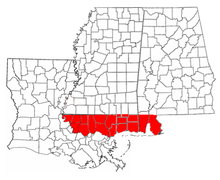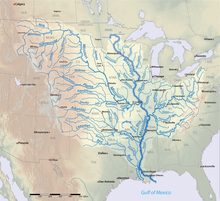The Adams–Onís Treaty (Spanish: Tratado de Adams-Onís) of 1819,[1] also known as the Transcontinental Treaty,[2] the Spanish Cession,[3] the Florida Purchase Treaty,[4] or the Florida Treaty,[5][6] was a treaty between the United States and Spain in 1819 that ceded Florida to the U.S. and defined the boundary between the U.S. and Mexico (New Spain). It settled a standing border dispute between the two countries and was considered a triumph of American diplomacy. It came during the successful Spanish American wars of independence against Spain.
Florida had become a burden to Spain, which could not afford to send settlers or man garrisons, so Madrid decided to cede the territory to the United States in exchange for settling the boundary dispute along the Sabine River in Spanish Texas. The treaty established the boundary of U.S. territory and claims through the Rocky Mountains and west to the Pacific Ocean, in exchange for Washington paying residents' claims against the Spanish government up to a total of $5 million Spanish dollars[7] (purchasing power equivalent to US$99,500,000 in 2023) and relinquishing the U.S. claims on parts of Spanish Texas west of the Sabine River and other Spanish areas, under the terms of the Louisiana Purchase.
The treaty remained in full effect for only 183 days: from February 22, 1821, to August 24, 1821, when Spanish military officials signed the Treaty of Córdoba acknowledging the independence of Mexico; Spain repudiated that treaty, but Mexico effectively took control of Spain's former colony. The Treaty of Limits between Mexico and the United States, signed in 1828 and effective in 1832, recognized the border defined by the Adams–Onís Treaty as the boundary between the two nations.
The Adams–Onís Treaty was negotiated by John Quincy Adams, the Secretary of State under U.S. President James Monroe, and the Spanish "minister plenipotentiary" (diplomatic envoy) Luis de Onís y González-Vara, during the reign of King Ferdinand VII.[8]


Spain had long rejected repeated American efforts to purchase Florida. But by 1818, Spain was facing a troubling colonial situation in which the cession of Florida made sense. Spain had been exhausted by the Peninsular War (1807–1814) against Napoleon in Europe and needed to rebuild its credibility and presence in its colonies. Revolutionaries in Central America and South America had been waging wars of independence since 1810. Spain was unwilling to invest further in Florida, encroached on by American settlers, and it worried about the border between New Spain (a large area including today's Mexico, Central America, and much of the current U.S. western states) and the United States. With minor military presence in Florida, Spain was not able to restrain the Seminole warriors who routinely crossed the border and raided American villages and farms, as well as protected southern slave refugees from slave owners and traders of the southern United States.[9]
The United States from 1810 to 1813 annexed and then invaded most of West Florida (already independent as the Republic of West Florida west of the Pearl River) up to the Perdido River (modern border river between the states of Alabama and Florida), claiming that the Louisiana Purchase covered West Florida also.[10] General James Wilkinson invaded and occupied Mobile during the War of 1812 and the Spanish never returned to West Florida west of the Perdido River.
The State of Muskogee (1799–1803) demonstrated Spain's inability to control the interior of East Florida, at least de facto; the Spanish presence had been reduced to the capital (San Agustín) and other coastal cities, while the interior belonged to the Seminole nation.[citation needed]
While fighting escaped African-American slaves, outlaws, and Native Americans in U.S.-controlled Georgia during the First Seminole War, American General Andrew Jackson had pursued them into Spanish Florida. He built Fort Scott, at the southern border of Georgia (i.e., the U.S.), and used it to destroy the Negro Fort in northwest Florida, whose existence was perceived as an intolerably disruptive risk by Georgia plantation owners.
To stop the Seminole based in East Florida from raiding Georgia settlements and offering havens for runaway slaves, the U.S. Army led increasingly frequent incursions into Spanish territory. This included the 1817–1818 campaign by Andrew Jackson that became known as the First Seminole War, after which the U.S. effectively seized control of Florida; albeit for purposes of lawful government and administration in Georgia and not for the outright annexation of territory for the U.S. Adams said the U.S. had to take control because Florida (along the border of Georgia and Alabama Territory) had become "a derelict open to the occupancy of every enemy, civilized or savage, of the United States, and serving no other earthly purpose than as a post of annoyance to them".[11][12] Spain asked for British intervention, but London declined to assist Spain in the negotiations. Some of President Monroe's cabinet demanded Jackson's immediate dismissal for invading Florida, but Adams realized that his success had given the U.S. a favorable diplomatic position. Adams was able to negotiate very favorable terms.[9]

In 1521, the Spanish Empire created the Virreinato de Nueva España (Viceroyalty of New Spain) to govern its conquests in the Caribbean, North America, and later the Pacific Ocean. In 1682, La Salle claimed Louisiana for France.[13] For the Spanish Empire, this was an intrusion into the northeastern frontier of New Spain. In 1691, Spain created the Province of Tejas in an attempt to inhibit French settlement west of the Mississippi River. Fearing the loss of his American territories in the Seven Years' War, King Louis XV of France ceded Louisiana to King Charles III of Spain with the secret Treaty of Fontainebleau in 1762. The Treaty of Paris of 1763 split Louisiana with the portion east of the Mississippi River (except for Île d'Orléans) becoming a part of British North America and the portion west of the river becoming the District of Louisiana within New Spain. This eliminated the French threat, and the Spanish provinces of Luisiana, Tejas, and Santa Fe de Nuevo México coexisted with only loosely defined borders. In 1800, French First Consul Napoleon Bonaparte forced King Charles IV of Spain to cede Louisiana to France with the secret Third Treaty of San Ildefonso. Spain continued to administer Louisiana until 1802 when Spain publicly transferred the district to France. The following year, Napoleon sold the territory to the United States to raise money for his military campaigns.[14]
The United States and the Spanish Empire disagreed over the territorial boundaries of the Louisiana Purchase of 1803. The United States maintained the claim of France that Louisiana included the Mississippi River and "all lands whose waters flow to it". To the west of New Orleans, the United States assumed the French claim to all land ea